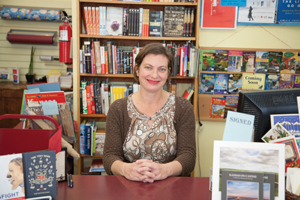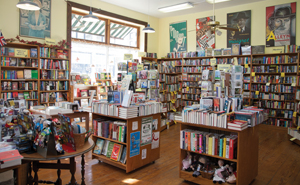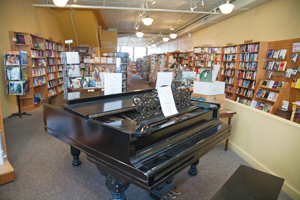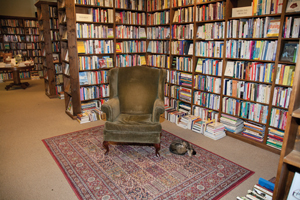| Fourth Quarter 2012 | story by DAISY WAKEFIELD | photos by STEVEN HERTZOG |

It is a modern day David and Goliath pairing happening all over the country — the independent, locally-owned bookstore out matched in size, resource, and price point by a giant, the online retailer Amazon. For symbolic small boys with slingshots, the story doesn’t always have a happy ending. According to the American Booksellers Association, a trade organization of independent booksellers, only about 1900 independent bookstores remain in the US. Ten years ago, their number was at 4000.
 Their feud, however, is not necessarily a picture of the bully picking on the little guy, as Amazon is not purposefully targeting small indie bookstores. These are simply not enough of a menace to put a dent in the billions of dollars that the behemoth commands. Th e shuttering of independent bookstores is just collateral damage in Amazon’s true targets — big box bookstores, like Borders, which was indeed conquered as they went out of business last year.
Their feud, however, is not necessarily a picture of the bully picking on the little guy, as Amazon is not purposefully targeting small indie bookstores. These are simply not enough of a menace to put a dent in the billions of dollars that the behemoth commands. Th e shuttering of independent bookstores is just collateral damage in Amazon’s true targets — big box bookstores, like Borders, which was indeed conquered as they went out of business last year.
But for local booksellers, the fight does feel personal. Especially when Amazon put on a promotion at the end of 2011 that encouraged consumers to go to a brick and mortar store, scan a book’s UPC code, and then buy it from Amazon in order to receive a 5% discount off of their purchase.
“It’s disappointing,” says Heidi Raak, owner of The Raven Bookstore. “The problem with Amazon in particular is that they use predatory pricing.”
This practice of predatory pricing is underpricing in order to drive out competition, and then eventually raising the price levels once a de facto monopoly is established. Predatory pricing is somewhat dependent on show rooming, in which consumers check out something in a physical store and then buy it online. A 2011 Codex study reveals that 28% of book buyers practiced show rooming before making their purchase online. Since Amazon commands 70% of the online literary market, show rooming most likely benefits them above any other online retailer.
 Raak, who has owned The Raven for five years, still believes that the power of customer service and a loyal customer base will help to sustain local bookstores.
Raak, who has owned The Raven for five years, still believes that the power of customer service and a loyal customer base will help to sustain local bookstores.
“We’ve implemented a few changes so that we can get any book within 3 days — definitely if there’s a book out there and it’s available, we will get it. There’s also something about being able to come in and have a recommendation given by the staff, who are like a family here. And if you wanted to read Catcher in the Rye, you could come in and get it that day. Even Amazon can’t deliver that fast.”
Besides behemoth online retailers, independent bookstores are also grappling with the swell of converts to e-readers. Proprietary e-readers like Amazon’s Kindle and Barnes and Noble’s Nook have wooed their own legions of readers. More significantly, the transfer of books from print to digital media has upended the publishing industry. This has unleashed a multitude of complexities which bode either harm or health to any of the various stops on the food chain of publishing.
 For Signs of Life, the choice is to fight fire with fire. The bookstore upgraded their website last year so that customers can order almost any printed book on their site as well as purchase e-books through them. They are also stocking the Kobo brand of e-readers in store, in time for the holiday season.
For Signs of Life, the choice is to fight fire with fire. The bookstore upgraded their website last year so that customers can order almost any printed book on their site as well as purchase e-books through them. They are also stocking the Kobo brand of e-readers in store, in time for the holiday season.
Clay Belcher, owner of Signs of Life, says, “Lawrence is a highly educated community. As such, we have far more technologically savvy customers. That’s why we are so pumped up about the new Kobo e-readers. We’re confident this new technology will resonate well with our clientele. Unlike other readers, the Kobo readers use a new e-ink technology which improves visibility under even the harshest lighting environment. This is a great new opportunity to serve our customers with state of the art e-readers.”
But for another of Lawrence’s long-standing independent bookstores, The Dusty Bookshelf, the allure and magic of browsing a bookstore cannot be found in an e-book. Admittedly, “Dusty”, as it is known to regulars, is a used bookstore, and thus has the ability to sidestep some of the direct competition that other retail bookstores grapple with. Customers come into the bookstore to browse the some 60,000 titles of used books, and many times, they stay to buy.
 Shannon Jones, district manager for The Dusty Bookshelf, says, “Browsing is an event. People will go out to dinner and then come here to browse and make a night of it. They come in because of the constantly moving inventory, and almost all of our titles are individual ones. So you don’t know what you’re going to find when you come here — it’s a treasure hunt.” and then there is the argument that true book lovers are purists, and will not read from an electronic device. The tactile and sensory engagement of having a “real” book is a large part of reading. And for people who are constantly in front of a screen, that sensation may be even more inviting.
Shannon Jones, district manager for The Dusty Bookshelf, says, “Browsing is an event. People will go out to dinner and then come here to browse and make a night of it. They come in because of the constantly moving inventory, and almost all of our titles are individual ones. So you don’t know what you’re going to find when you come here — it’s a treasure hunt.” and then there is the argument that true book lovers are purists, and will not read from an electronic device. The tactile and sensory engagement of having a “real” book is a large part of reading. And for people who are constantly in front of a screen, that sensation may be even more inviting.
“There’s something almost romantic about holding a book,” says Jones. “It provides a different sort of experience for people and a lot of our customers don’t want to lose that sense. There’s even a great smell to new books, and definitely to old books. If the Kindle starts piping in smells, we might have a problem.”
